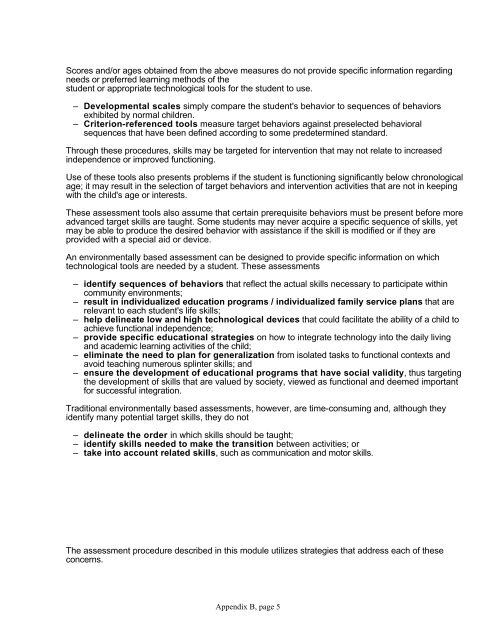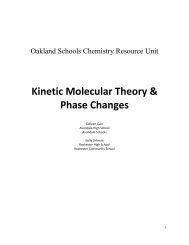Oakland Schools ASSISTIVE TECHNOLOGY GUIDELINES
Oakland Schools ASSISTIVE TECHNOLOGY GUIDELINES
Oakland Schools ASSISTIVE TECHNOLOGY GUIDELINES
Create successful ePaper yourself
Turn your PDF publications into a flip-book with our unique Google optimized e-Paper software.
Scores and/or ages obtained from the above measures do not provide specific information regarding<br />
needs or preferred learning methods of the<br />
student or appropriate technological tools for the student to use.<br />
– Developmental scales simply compare the student's behavior to sequences of behaviors<br />
exhibited by normal children.<br />
– Criterion-referenced tools measure target behaviors against preselected behavioral<br />
sequences that have been defined according to some predetermined standard.<br />
Through these procedures, skills may be targeted for intervention that may not relate to increased<br />
independence or improved functioning.<br />
Use of these tools also presents problems if the student is functioning significantly below chronological<br />
age; it may result in the selection of target behaviors and intervention activities that are not in keeping<br />
with the child's age or interests.<br />
These assessment tools also assume that certain prerequisite behaviors must be present before more<br />
advanced target skills are taught. Some students may never acquire a specific sequence of skills, yet<br />
may be able to produce the desired behavior with assistance if the skill is modified or if they are<br />
provided with a special aid or device.<br />
An environmentally based assessment can be designed to provide specific information on which<br />
technological tools are needed by a student. These assessments<br />
– identify sequences of behaviors that reflect the actual skills necessary to participate within<br />
community environments;<br />
– result in individualized education programs / individualized family service plans that are<br />
relevant to each student's life skills;<br />
– help delineate low and high technological devices that could facilitate the ability of a child to<br />
achieve functional independence;<br />
– provide specific educational strategies on how to integrate technology into the daily living<br />
and academic learning activities of the child;<br />
– eliminate the need to plan for generalization from isolated tasks to functional contexts and<br />
avoid teaching numerous splinter skills; and<br />
– ensure the development of educational programs that have social validity, thus targeting<br />
the development of skills that are valued by society, viewed as functional and deemed important<br />
for successful integration.<br />
Traditional environmentally based assessments, however, are time-consuming and, although they<br />
identify many potential target skills, they do not<br />
– delineate the order in which skills should be taught;<br />
– identify skills needed to make the transition between activities; or<br />
– take into account related skills, such as communication and motor skills.<br />
The assessment procedure described in this module utilizes strategies that address each of these<br />
concerns.<br />
Appendix B, page 5
















